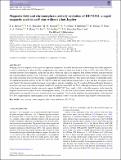Magnetic field and chromospheric activity evolution of HD 75332 : a rapid magnetic cycle in an F star without a hot Jupiter
Abstract
Studying cool star magnetic activity gives an important insight into the stellar dynamo and its relationship with stellar properties, as well as allowing us to place the Sun’s magnetism in the context of other stars. Only 61 Cyg A (K5V) and τ Boo (F8V) are currently known to have magnetic cycles like the Sun’s, where the large-scale magnetic field polarity reverses in phase with the star’s chromospheric activity cycles. τ Boo has a rapid ∼240 d magnetic cycle, and it is not yet clear whether this is related to the star’s thin convection zone or if the dynamo is accelerated by interactions between τ Boo and its hot Jupiter. To shed light on this, we studied the magnetic activity of HD 75332 (F7V) which has similar physical properties to τ Boo and does not appear to host a hot Jupiter. We characterized its long term chromospheric activity variability over 53 yrs and used Zeeman Doppler Imaging to reconstruct the large-scale surface magnetic field for 12 epochs between 2007 and 2019. Although we observe only one reversal of the large-scale magnetic dipole, our results suggest that HD 75332 has a rapid ∼1.06 yr solar-like magnetic cycle where the magnetic field evolves in phase with its chromospheric activity. If a solar-like cycle is present, reversals of the large-scale radial field polarity are expected to occur at around activity cycle maxima. This would be similar to the rapid magnetic cycle observed for τ Boo, suggesting that rapid magnetic cycles may be intrinsic to late-F stars and related to their shallow convection zones.
Citation
Brown , E L , Marsden , S C , Mengel , M W , Jeffers , S V , Millburn , I , Mittag , M , Petit , P , Vidotto , A A , Morin , J , See , V , Jardine , M & González-Pérez , J N 2021 , ' Magnetic field and chromospheric activity evolution of HD 75332 : a rapid magnetic cycle in an F star without a hot Jupiter ' , Monthly Notices of the Royal Astronomical Society , vol. 501 , no. 3 , pp. 3981–4003 . https://doi.org/10.1093/mnras/staa3878
Publication
Monthly Notices of the Royal Astronomical Society
Status
Peer reviewed
ISSN
0035-8711Type
Journal article
Description
ELB is supported by an Australian Government Research Training Program (RTP) Scholarship. SJ acknowledges the support of the German Science Foundation (DFG) Research Unit FOR2544 ‘Blue Planets around Red Stars’ (project JE 701/3-1) and DFG priority program SPP 1992 ‘Exploring the Diversity of Extrasolar Planets’ (JE 701/5-1). AAV acknowledges funding from the European Research Council (ERC) under the European Union’s Horizon 2020 research and innovation programme (grant agreement No 817540, ASTROFLOW). VS acknowledges funding from the European Research Council (ERC) under the European Unions Horizon 2020 research and innovation programme (grant agreement No. 682393 AWESoMeStars).Collections
Items in the St Andrews Research Repository are protected by copyright, with all rights reserved, unless otherwise indicated.

